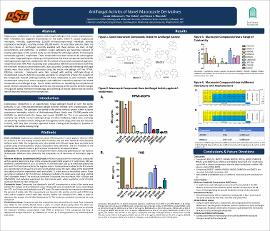| dc.contributor.advisor | Wozniak, Karen | |
| dc.contributor.author | Lieberman, Jacob A. | |
| dc.contributor.author | Hubin, Tim | |
| dc.contributor.other | Wentz Research Scholars | |
| dc.date.accessioned | 2023-05-11T21:26:01Z | |
| dc.date.available | 2023-05-11T21:26:01Z | |
| dc.date.issued | 2023-04-27 | |
| dc.identifier | oksd_wentz_2023_lieberman | |
| dc.identifier.citation | Lieberman, J., Hubin, T., Wozniak, K. (2023) Antifungal activity of novel microcycle derivatives. Poster session presented at the Oklahoma State University Wentz Research Scholars Symposium, Stillwater, OK. | |
| dc.identifier.uri | https://hdl.handle.net/11244/337649 | |
| dc.description.abstract | Cryptococcus neoformans is an opportunistic fungal pathogen that causes cryptococcosis. After inhalation, the organism disseminates to the brain, where it causes cryptococcal meningitis. Annually, approximately 225,000 immunocompromised individuals develop cryptococcal meningitis, resulting in over 181,000 deaths. To treat these patients, there are only four classes of antifungals currently available and these options are toxic at high concentrations and ineffective. In addition, fungal pathogens are becoming resistant to existing antifungals. In the current study, we are testing the antifungal activity of macrocycle compounds against C. neoformans. These compounds have been shown to be active against many other fungal pathogens, allowing us to hypothesize that these compounds would exhibit antifungal activity against C. neoformans. We first tested 12 macrocycle compounds against C. neoformans strain H99. After incubating each compound at different concentrations with H99, the minimum inhibitory concentration (MIC) was calculated. Compounds exhibiting antifungal activity were then tested for cytotoxicity using the mouse macrophage cell line J774.A. Effective, non-toxic compounds were then assayed with existing antifungal drugs in checkerboard assays to determine possible synergistic or antagonistic activity. The majority of the compounds showed antifungal activity. Of these compounds, 6 were non-toxic. Initial checkerboard assays have shown synergistic and indifferent interactions between the tested compounds and antifungal drugs. Future studies will focus on identifying the mechanism of action of these compounds. Confocal and electron microscopy will be used to identify changes in fungal cell wall & membrane morphology, and screening of mutant libraries will be used to identify mutants resistant to these compounds. | |
| dc.description.sponsorship | Lew Wentz Foundation | |
| dc.format | application/pdf | |
| dc.language | en_US | |
| dc.publisher | Oklahoma State University | |
| dc.rights | In the Oklahoma State University Library's institutional repository this paper is made available through the open access principles and the terms of agreement/consent between the author(s) and the publisher. The permission policy on the use, reproduction or distribution of the article falls under fair use for educational, scholarship, and research purposes. Contact Digital Resources and Discovery Services at lib-dls@okstate.edu or 405-744-9161 for further information. | |
| dc.title | Antifungal activity of novel microcycle derivatives | |
| osu.filename | oksd_wentz_2023_lieberman.pdf | |
| dc.description.department | Microbiology and Molecular Genetics | |
| dc.description.department | Chemistry | |
| dc.description.department | Physics | |
| dc.type.genre | Poster | |
| dc.type.material | Text | |
| dc.type.material | Image | |
| dc.subject.keywords | cryptococcus neoformans | |
| dc.subject.keywords | antifungal | |
